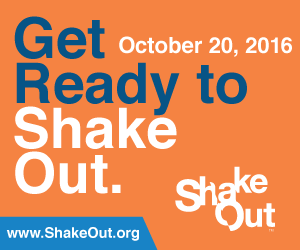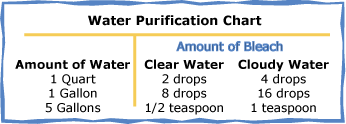
 Experts agree: Drop, Cover and Hold is the best way to protect yourself during earthquake shaking
Experts agree: Drop, Cover and Hold is the best way to protect yourself during earthquake shaking
Yesterday was the annual Great ShakeOut Day, a unified worldwide effort to practice how to be safer during earthquakes. From California to Japan, (and in hundreds of cities, states and countries in between), millions of people practiced the Drop, Cover and Hold drill, at 10:20 am on October 20th. The ShakeOut, which began in California in 2008, is not only an opportunity for communities, schools and other organizations to practice safety drills, it’s also a time to review and update emergency preparedness plans and supplies.
And, since emergency preparedness goes well beyond just being ready for the next big earthquake, I couldn’t pass up this opportunity to write about what is likely the most important part of everyone’s emergency kit: WATER.
The body can go without food for upwards of 30 days but will last less than one week without water. So if you’re going to do just one thing to prepare for an emergency, store water!
A supply of one gallon per person per day for 3-days, is the minimum that you should keep on-hand. At least a 7-day supply is optimal. So, if you have four people in your household, you should have at least 12 gallons of water stored at all times.
 Whatever size bottle you choose, water stored should equal at least one gallon per person per day for 3-days; a 7-day supply is optimal
Whatever size bottle you choose, water stored should equal at least one gallon per person per day for 3-days; a 7-day supply is optimal
If you’ve read some of my other posts, like What’s On Tap? It’s Hetch Hetchy For Me! and I’m a “Personal” Water Bottle Addict – Here Are My 5 Faves, then you know that I’m not an advocate of buying bottled water. However, in this case, I urge you to give yourself peace of mind by buying, at least a 3-day supply, of bottled water for your family today! Mark the date on the water bottles, find a place to store them, and make a note on your calendar to replace them after one-year.
It’s important to be prepared as possible, however even a stored water supply may be exhausted during a true emergency. In this case, there are several alternative emergency sources to keep in mind. If you’re in your home, water stored in your hot water tank, melted ice cubes from the freezer and water from unsalted canned vegetables are all potential sources. If you’re in a situation where you have questions about the quality of the water, purify it before drinking. To purify water, you can heat water to boiling or use commercial purification tablets, such as Potable Aqua. You can also use household liquid bleach if it’s pure and unscented; the label should say that it contains 8.25% of sodium hypochlorite and indicate that it’s suitable for disinfection and sanitation. Do not use scented, color safe, or bleaches with added cleaners. To purify water with bleach, use the following table as a guide:

After adding bleach, shake or stir the water container and let it stand for 30 minutes before drinking. Visit the Federal Emergency Management Agency (FEMA) website for additional guidance on preparing and storing an emergency water supply. I also recommend printing and keeping handy this Emergency Disinfection of Drinking Water fact sheet.
Organizing an emergency supply kit for my family is something that I’m always putting off. It seems to continually be on my “to-do list”, but never quite makes it to the top or gets priority. There’s always something else that seems more “urgent” or worthy of my time. However, I do always keep water on hand in my garage; this is something that is easy to do and, in my opinion, the minimum that anyone should do…..especially since I live in California. In researching for this post I printed the checklists and fact sheets that are linked, as the start to finally getting a full emergency kit and plan together. Alongside our regular kid-centric activities for this weekend, which include a birthday party, gardening at my daughter’s elementary school, and gymnastics class, I blocked several hours to make a full emergency kit. Now that my kids are old enough to help, I figure making the kit together can be both an educational and fun activity to do with them. Hopefully moving this item from the status of a “to-do” on a never ending list, to a “scheduled activity with kids” will finally make it happen!

One Reply to “”